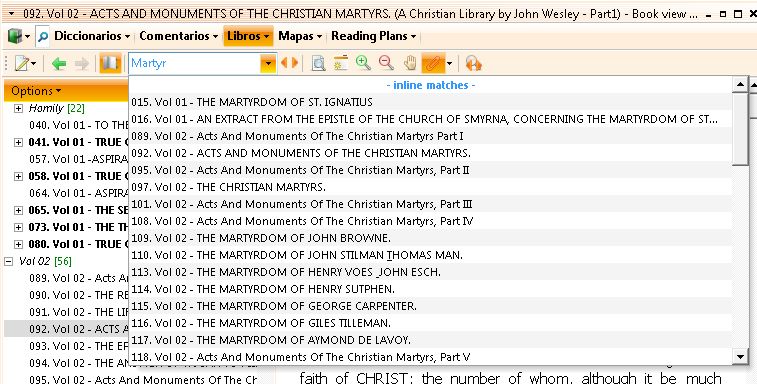04 Module Creation Reformatting In this class, we will look at reformatting of material within your module when you create a theWord module.
More Articles from this Category
- Using the Commentary Template
- Topic Formatting issues revisited
- Topic formatting Issues
- theWord hyperlink creation in theWord
- The End all of Text Manipulators
- Simple Bible Reader
The Best way to change Formatting
The absolutely best way to get good formatting is to get a good source document to start with. If your document is in Microsoft Word or RTF, and you create the document yourself, your best bet is to work on the formatting in a Word Processor. You have the advantage of making macros to do specific stuff. This is extremely helpful for modifying the format of text.
 .
.
Please help us keep this website up. We work hard to be a blessing to you. Donate to us. Even a $5 or $10 donation is greatly appreciated. All donations will go to pay hosting and domain fees.
You can use your PayPal account if you have one, or you can donate using any normal debit or credit card, pay through PayPal and chose just Debit or Credit Card.
At one time, I was using an old version of Microsoft Word, and I had learned the WordBasic or whatever they called it for the inherent Word macro language. I had all kinds of one-off macros I had created to do specific things. I had theWord open and Microsoft Word, and I would copy and paste text from one place to the other, run a macro, and select all and delete to the clipboard, switch back to theWord and insert. Easy and greatly sped up as far as production goes. I lost that computer and reinstalled it on another computer, and I had backups of the macros, but I couldn’t find the original disks of that old Microsoft Word program. As such, I have suffered greatly in my reformatting abilities since.
But not-with-standing, if you have Microsoft Word or Open Office, these are the places to do things as far as formatting is concerned.
The optimum workflow here is that you do the massive search and replace and formatting when the entire document is together. If you have a 500-page work, and it has 50 chapters, you do not want to go back once the module is in theWord and reformat all text from 10 to 12 font. Especially if there are headings and things at other font sizes.
Yes, you can do that kind of formatting in theWord, but you have to do it individually by hand in each topic. That can be a tremendous pain.
Macro Programs
There are some macro programs out there that will allow you to insert keystrokes into a program like the Word, and you can automate this formatting work, but again, this is just bad all the way around. It is almost easier to take all the chapter content of the work, dump it back into a word processing format, and do it right there.
Checklist for Module Completion
When I create a module, I usually innately do some things. I am trying to remember these things here to help you.
-
- Did you fill out the module properties dialog, including a tw module identifier number?
- Is the work abbreviation short but instructive?
- Did you detect Bible references?
- Did I make a table of contents?
- Did I make hyperlinks and check them? (I like a module that has the table of contents linked to each chapter so the chapter will pop up on mouse over)
- Are the font size and the font selection correct? (Costas recommends Font Tahoma 10 for all modules).
- Is there some white space between paragraphs?
- Are there broken lines (a linefeed which breaks a line when it is not ending in a punctuation mark)?
- Are there two or three extra paragraph marks at places leaving too much white space? (what you see in a word processor and in theWord is different, so remember to check things in theWord. Also, note that theWord needs fonts reduced because of small program real estate and that also means eliminating unnecessary white space and reducing super fonts).
- Is there Greek or Hebrew words in the text that need to be converted so that they are readable? (In general, is there garbled text anywhere? This comes in OCRed works mainly.) I can help with some of the Greek and Hebrew converting. [email protected]
- Are your images a good size? Remember that most of the time, the actual size of the window where a module will appear will be rather small. So don’t have images that take up the entire screen. Medium sized images are best. If they are maps, that is different, but icons and such usually bloat the size of the module.
- Is your module too large? If it is, then go into Module properties and compress it and see if that helps. If still very large (over 20MB or 30MB for anything that is under 100 pages) then go back and delete unneeded images, or take your images into an image compression program and resize them. This Images: jpeg-optimizer.com is a good site that will optimize jpeg images. Note that you have two rules here, the smaller is better is the general rule. (Actually, no images is best if you can get away with it). But in the case of detailed images, like maps, medium sized to large images is better, and they should be optimized. Too many images make a module hard to get through the download process and to use within theWord.
- Are all the topics (actual chapters) the same as the table of contents?
- Note, avoid abbreviations in Book Chapter titles in the topics. If you click on the topic drop down box, you can start typing a word, and tw will search within the topic titles and bring up all the ones that match. If you abbreviate words in your topics, you will kill this feature. For example, in this work from John Wesley library, I typed “martyr” and got inline matches. If you abbreviated “martyr” with “mart.” then most people will not pick up on that, and they may have your module, but doing an across your library search like that, they won’t type “mart” but “martyr”. All these chapters will be missed, i.e. they won’t come up in the search results.

- Did you move the Preface, Introduction, and Foreword into the Table of Contents page? (These things should be after the actual listing of the chapters. They usually are not important enough to occupy their own topic. Titles like these also would be in most books, so searching for them is not going to be beneficial, i.e. 1000 hits on every book in your library (and none of them have any more information like “Introduction to Attributes of God“) is not helpful.
- Did you change “Title” topic into something more specific? When you search for a word in tw bookview search, “Title” will not tell you anything about the book. It is much better to change “Title” to something like “Arthur Pink – The Attributes of God”. In my version of that work, instead of “Title” or “Table of Contents” I named the table of contents, “Pink {Reformed}{Baptist}- The Attributes of God”. That will definitely come up in search results if you are looking for the “attributes of God” for example. Look seriously at the topic chapter titles. In that book, none of his chapters have “attributes of God” in it. Search your library and you would be surprised what won’t come up in a search. That is because keywords are not in the book chapter titles (topics). Good form is to put some of these like “(attributes of God)” after the book topics. It will help your users later on, and they will be greatly appreciative.
- Did you take the word “Chapter” out of the topics so that you can see more of the actual chapter title?
- Did you convert roman numerals in the chapter titles to Arabic?
- Did you scan the entire document to look to see if the original author used roman numerals instead of Arabic numbers in verse references? (John iii.16 versus John 3:16). tw will not detect roman numerals.
- Is there missing material (check in your source material that there are no text at the end of a chapter with no punctuation. If there is part of the text may have been cut off so try to find it).
- Did you lock your module against user changes?
- Did you prepare the module for distribution (should be the last thing done before uploading to the Internet)?
Conclusion and Recommendation
When you are going to start making modules, attack it from a point of view that you are going to grow into this. If you have several modules, take the smallest one, and start there. Convert (copy and paste) 3-4 chapters, and detect verse references, and then go back and actually read some paragraphs and see if the tooltipping is working right.
There is no substitute for working out your problems and procedures on a 4 chapter 40 page work instead of a 500 page 50 chapter work. Use the small stuff to perfect HOW YOU ARE GOING TO DO IT, and get your procedure down way before you try something really large.
If at all possible, use beta-testers. Send your small beginning module to some friends with theWord, and ask them to install it, and then give you feedback. Is the font hard to read? The font size too small or too large? Do you have a table of contents, or do you even need one? Etc.
Get this series of posts in PDF format

